![]()
![]()
![]()
Use LEFT and RIGHT arrow keys to navigate between flashcards;
Use UP and DOWN arrow keys to flip the card;
H to show hint;
A reads text to speech;
55 Cards in this Set
- Front
- Back
|
The practice of grouping of organisms together based on the processes that resulted in the evolution of the characteristic of the organism is called: A. Systematics B. Systems mechanics C. Sistine Chapel D. Systole E. None of the Above |
A. systematics |
|
|
A trait that has arisen in two species that come from ancestors who did not also have that same trait are said to have an analogous trait or homologous trait? A. Homologous trait B. Analogous trait |
B. Analogous trait |
|
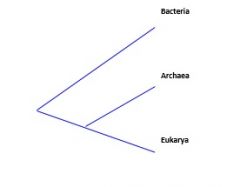
Based on this figure, which two groups are most closely related?
A. Bacteria and Archaea B. Bacteria and Eukarya C. Archaea and Eukarya |
C. Archaea and Eukarya |
|
|
An individual with two same copies of one gene is said to be: A. Heterozygous B. Homozygous C. Homophonic D. Hybrid E. Both A and E |
B. Homozygous |
|
|
One of the following was the name on the title of a prelab on evolution. Which was it? A. Hersey-Chase B. Watson-Crick C. Tom-Jerry D. Hardy-Weinberg E. Pavlov-Konning |
D. Hardy-Weinberg |
|
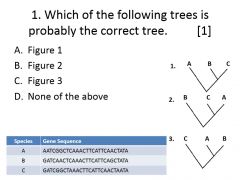
|
C. Figure 3 |
|
|
Which of the following is not a condition for Hardy-Weinberg: A. Large population B. No gene flow C. No mutation D. Random mating E. Natural selection |
E. Natural Selection |
|
|
A fitness of 0.5 means that the organism with the genotype will die if one of the alleles is not fit. A. True B. False |
B. False |
|
|
If the frequency of homozygote dominant genotypes is 0.0625 what is the frequency to the recessive allele? A. 0.5 B. 0.25 C. 0.75 D. 0.0625 E. 1.0 |
C. 0.75 |
|
|
In the PopG graph, what quantity is on the X-axis? A. Allele frequency B. Population size C. Number of fixations D. Number of generations |
D. Number of generations |
|
|
Which of the following populations are not in genetic equilibrium?
I. A population of snowshoe hares where individuals with a gene for longer fur are more likely to survive the winter. II. A population of live oaks where flowers are occasionally pollinated by pollen from a different population on the other side of a major river. III. A population of individuals on a computer where the Q allele for a particular gene is dominant over the q allele.
A. I only B. II only C. III only D. Both I and III E. Both I and II |
E. Both I and II |
|
|
Evolution is defined as the change in allele frequencies in a/an __________________ over time. A. Cell B. Individual C. Population D. Species E. Community |
C. Population |
|
|
Blue eye-color is a recessive character to brown eye-color. In Estonia, 99% of the population has blue eyes. Based on this information, which is the less fit character? A. Brown eye color B. Blue eye color C. Not enough information provided. |
C. Not enough information provided. |
|
|
Blue eye-color is a recessive character to brown eye-color. In Estonia, 99% of the population has blue eyes. How do you think blue eyes became the dominant phenotype even though brown eyes are the dominant character? A. Natural Selection B. Genetic drift C. Because beauty is in the eyes of the beholder. D. Evolution E. Induced mutation |
B. Genetic drift |
|
|
CFTR is a gene that has been attributed to cystic fibrosis. Normally it is a chloride channel but a mutation causes it to lose its function. What would you predict will happen to CFTR gene after many generations have passed? A. Because of reduced fitness it will be removed from the population. B. It will go to fixation in the human population because of drift. C. It may go to fixation in a small population of humans because of drift. D. Cannot tell from the information provided. E. Both A and C could be valid answers. |
E. Both A and C could be valid answers |
|
|
A population of birds consist of red-breasted and yellow-breasted individuals. The color is determined by the alleles C (red) and c (yellow). If the initial frequencies of the C allele is 0.7 and the population mates randomly (in Hardy Weinberg) what would you expect in 100 generations? A. The population of hybrids with orange-breasts will increase. B. Red coloration will be fixed in the population. C. The population will become extinct. D. The frequency of yellow alleles will be close to 0.3. E. The species will evolve into two species with red color and the other with yellow color. |
D. The frequency of yellow alleles will be close to 0.3. |
|
|
A biologist studying a population of birds comprised of some individuals with long-tailed and some short-tailed individuals. She is interested in whether a population of birds is randomly mating or if the birds are preferentially mating with their own tail type. In this species tail length is controlled by a single gene with two alleles (T=long, t=short) where the long tail is dominant. To examine this aspect the scientist will use controlled populations of birds and assess the results of the mating that occurs. Which of the following would be an appropriate null hypothesis? A. The population of birds is mating randomly. B. If the population of birds is mating randomly the length of the tails will change. C. If the population of birds is mating randomly the gene frequencies will change. D. If the population of birds is mating randomly the gene frequencies will stay the same. E. If the population of birds is mating randomly the gene T will go to fixation and all birds will have long tails. |
D. If the population of birds is mating randomly the gene frequencies will stay the same |
|
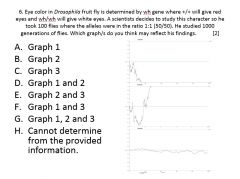
|
D. Graph 1 and 2 |
|
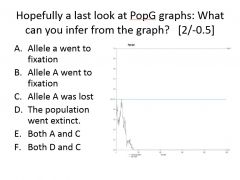
|
E. Both A and C |
|
|
Humans are still evolving. A. True B. False |
A. True |
|
|
Evolution is not... A. A myth B. The story of how humans evolved from apes. C. Survival only of the fittest. D. A law E. All of the above |
E. all of the above |
|
|
Getting into ecology now you should know what the fundamental difference between a population and a community is: A. Population is a number of organisms; community is not. B. Populations evolve, communities do not. C. Population deals with a single species, community deals with many. D. Populations are large, communities are small. E. Both B and C F. All of the above |
C. Population deals with a single species, community deals with many. |
|
|
Which of the following are abiotic components affecting population growth? A. Temperature B. Competition (Inter-specific/Intra-specific) C. pH D. Light intensity E. A and C F. A, C, and D G. All of the above |
F. A, C, and D |
|
|
Which of the following is a density independent factor for population growth? A. Natural disasters B. Disease C. Scarcity of food D. Competition E. B and D F. All of the above |
A. Natural disasters |
|
|
The current human population is approximately 7.1 billion. A. True B. False |
A. True |
|
|
Population comprises of _____________ species. Community comprises of _______________ species. Ecosystem is the __________________ species along with their interactions with themselves and their surrounding. |
a single
many populations of different species
community of species |
|
|
What organism were we working with in the lab? A. Chlamydia B. Chlamydobacter C. Chlamydomonas D. Eclampsia E. None of the above |
C. Chlamydomonas |
|
|
Which process does your organism not undergo in the test tubes? A. Photosynthesis B. Respiration C. Cell Division D. Sexual Reproduction E. None of the above |
E. None of the above |
|
|
The absorbance at 750 nm was measured to be 0.450, using the yellow sheets, how many of your organisms would you expect per milliliter? A. 0.4274 B. 0.4739 C. 474 D. 427400 E. 473900 |
D. 427400 |
|
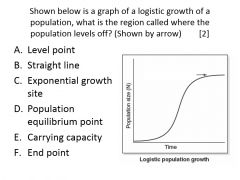
|
E. Carrying capacity |
|
|
Most of you went out to the lakes to collect water or sampled lake water, among the tests you did on that which one measured was a biotic factor? A. pH B. Clarity C. Depth D. Chlorophyll E. Dissolved Oxygen F. All of them are abiotic |
D. Chlorophyll |
|
|
Which of the following chemicals would contain Nitrogen? A. DNA B. Amino Acid C. Proteins D. Air E. Soil F. All of the above G. None of the above |
F. All of the above |
|
|
Which of the following chemicals would contain Phosphorus? A. DNA B. Amino Acid C. Proteins D. Air E. Soil F. A, B, and C G. A, C, and E H. A, D, and E |
G. A, C, and E |
|
|
The producers in an ecosystem are known as: A. Autotrophs B. Heterotrophs C. Photolytes D. Phytocytes E. A and D F. None of the above |
A. Autotrophs |
|
|
We get Nitrogen in our bodies from: A. Air B. Water C. Soil D. Plants E. Animals F. D and A G. D and E |
G. D and E |
|
|
Phosphorus in our food is present in the form of: A. Metallic Phosphorus B. P4 C. Phosphate D. Phosphite E. Phosphide F. Phosphorus pentoxide |
C. Phosphate |
|
|
During photosynthesis: A. CO2 is used and O2 is released B. O2 is used and CO2 is released C. sunlight is converted to energy D. Glucose is produced E. Glucose is used F. A, C, and D G. A, C, and E H. B, C, and D I. B, C, and E |
F. A, C, and D |
|
|
Bacteria present in root nodules of leguminous plants: A. convert atmospheric nitrogen to ammonia B. convert atmospheric nitrogen to nitrates C. Convert ammonia to nitrates D. Converts nitrates to nitrites E. Converts nitrates to free nitrogen |
A. Convert atmospheric nitrogen to ammonia |
|
|
Nitrogen present in our bodies are returned back to the abiotic Earth by: A. Parasites B. Saprophytes C. Hyenas D. Vultures E. Heterotrophs F. Detritus |
B. Saprophytes |
|
|
You will notice that your Chlamydomonas populations may have started decreasing, what is the most likely cause of this? A. Population is growing old. B. Population is evolving C. Population has reached carrying capacity. D. Cannibalism E. Coincidence F. None of the above |
C. Population has reached carrying capacity |
|
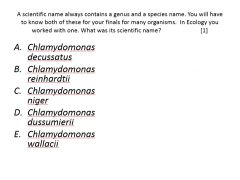
|
B. Chlamydomonas reinhardtii |
|
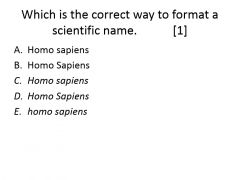
|
C. Homo sapiens |
|
|
What is true to an eukaryote? A. They always have a membrane bound nucleus. B. They always have mitochondria or chloroplasts C. They are always motile D. They cannot reproduce sexually. |
A. They always have a membrane bound nucleus. |
|
|
Which of these are prokaryotic? A. Archaea B. Bacteria C. Protista D. Fungi E. Plants F. Animals G. A and B H. A, B, and C I. All of the above |
G. A and B |
|
|
All bacteria cause disease? A. True B. False |
B. False |
|

|
C. Bacillus |
|
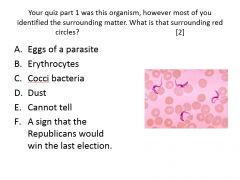
|
B. Erythrocytes |
|
|
Which of the following enjoys salty environments? A. Methanogens B. Halophiles C. Halophytes D. Thermophiles E. Both A and C F. Both A and B |
B. Halophiles |
|
|
Which of the following is not a kingdom: A. Bacteria B. Protista C. Eukarya D. Archaea E. Plants F. Animals G. Fungi H. All of them are kingdoms |
C. Eukarya |
|
|
Bacteria contain introns in their DNA. A. True B. False |
B. False |
|
|
Which of the following plant groups lack a vascular system? A. Hepatophyta B. Pterophyta C. Coniferophyta D. Cycadophyta E. Anthophyta F. All except A |
A. Hepatophyta |
|
|
The part of a fern plant that you see is a A. Gametophyte B. Sporophyte C. Chlorophyte D. Maculophyte E. Haplophyte F. Diplophyte |
B. Sporophyte |
|
|
Plants are green because: A. It is a cheap color B. Plant wastes such as ammonia and urea are green in color and are stored in the leaves C. Chlorophyll is a green pigment found only in plants that give them the green color. D. Plant waxes that coat a plant reflect green light E. None of the above. |
C. Chlorophyll is a green pigment found only in plants that give them the green color. |
|

|
F. Eukarya |
|
|
How many germ layers does a human have? A. 1 B. 2 C. 3 D. 4 E. 5 F. 0 |
C. 3 |

